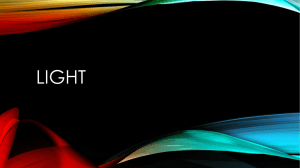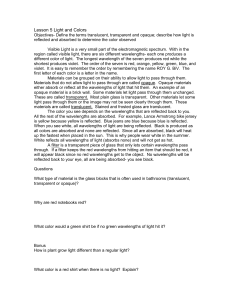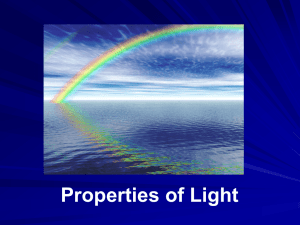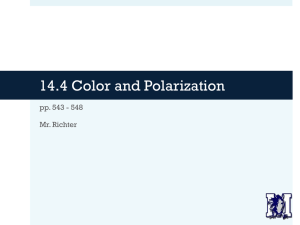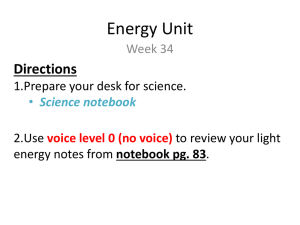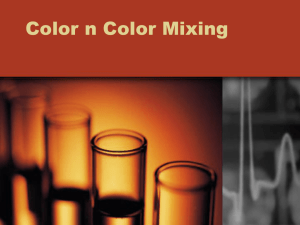Interactions of Light with Matter Chapter 3 Section 2
advertisement
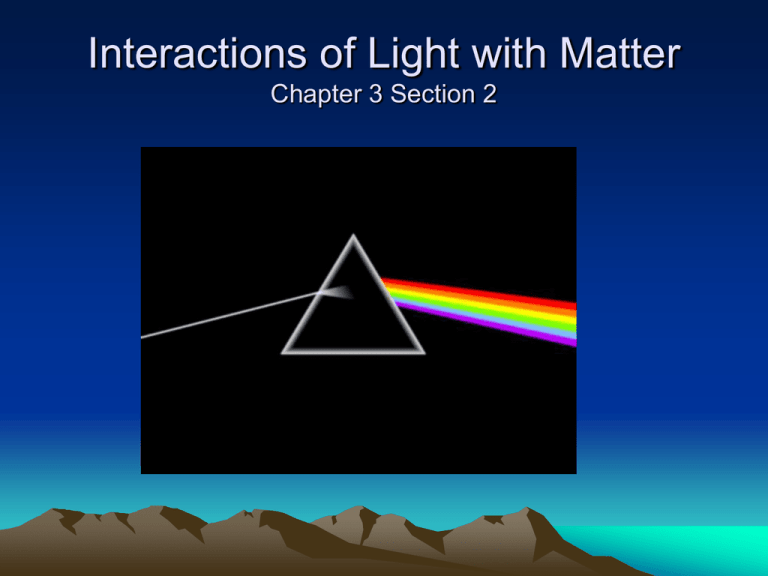
Interactions of Light with Matter Chapter 3 Section 2 How does light travel? • In a straight line unless it hits object or is absorbed What is reflection? • Light bouncing off an object • Changes direction of light • Like a ball bouncing off ground What is “Law of Reflection”? • Angle made by light hitting surface = angle of light reflected What are the types of Reflection”? • Regular reflection: light reflects off mirror at same angle; surface smooth/ shiny – mirror What are the types of Reflection? • Diffuse reflection: light reflects in many directions; surface rough/bumpy – wall; can’t see reflection What are the types of Reflection? • Regular (Spectacular) • Diffuse What are the light sources? • Luminous - object produces visible light • Illuminated – object needs a separate light source to be seen • Importance? Sight needs light; to be seen must either be luminous or be illuminated Interactions of Light with Matter Chapter 3 Section 2 Part II What is absorption of light? • Transfer of energy to particles of matter • Explains why light dims as it moves from light source: more particles absorb the energy, making it dimmer What is scattering of light? • Light moving in all directions after colliding with particles • Fog is good example • Allows you to see outside beam, but it dims • Explains why sky is blue: shorter wavelength is scattered more than other colors, so you see more of it How does light interact with matter? • Reflected – bounces off • Transmitted – passes through matter; example through a window • Absorbed – transfer light energy to matter; makes object feel warmer • (next section) Refracted – wave is bent How does transparent, translucent, or opaque matter matter? • Transparent: easily transmits visible light (air, glass, H2O) • Translucent: transmits light but also scatters it (wax paper) • Opaque: doesn’t transmit light (metal, wood, textbook) How is an object’s color determined? • Wavelength determines • Eyes receive light • Eyes send messages to brain • Brain interprets signals as colors • Long = red / short = violet / mixture of waves = combination of colors With opaque objects, how does reflection and absorption impact the color? • Light hits opaque object: Some waves reflected, see that color Some absorbed, don’t see that color How do we see a strawberry as red? • Red wavelengths reflected; other colors’ wavelengths absorbed What makes something white? • All colors’ wavelengths are reflected What makes something black? • All colors’ wavelengths are absorbed What about color in non-opaque objects? • Transparent: Colorless in white light because all light waves pass through (transmit). Think of glass window. • Translucent: Shows color of wavelength reflected or transmitted; all others absorbed. Think of stained glass. How do pigments produce color? • Pigment = material that absorbs some colors of light and reflects other What has pigment? • Pigment is in almost everything What are two examples of pigments? • Melanin = pigment for skin color • Chlorophyll = plant color What happens when pigments are mixed? • Each pigment absorbs at least 1 color • Mix pigments, more colors are taken away; color subtraction
